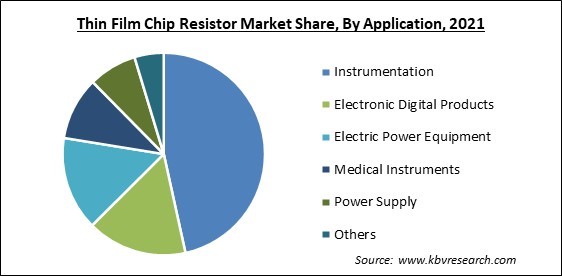
The Global Thin Film Chip Resistor Market size is expected to reach $885.9 Million by 2028, rising at a market growth of 5.4% CAGR during the forecast period.
A resistor that uses a thin resistance layer is referred to as a thin-film resistor. This layer is set atop a ceramic foundation. Unlike the thick film resistors, this resistor's thickness is incredibly thin, just about 0.1 microns. Since they are more precise, stable, and have a better temperature coefficient, these resistors are frequently used in higher precision solutions. Surface-mounted integrated circuit (IC) components like thin film chip resistors provide a defined resistance to the electrical current passing through them.

These are very small surface-mounted electronic components that come in rectangle or square chip packages. They are employed to run, protect, and manage circuits. Thin film chip resistors can either have a fixed resistance value or one that is variable or changeable within a certain range. Vacuum deposition or sputtering is employed to place the resistive layer upon a ceramic substrate. A homogenous metallic layer of approximately 0.1 μm thickness is produced as a result. Nichrome, an alloy of chromium and nickel, is frequently employed for the formation of metallic layer.
Several layer thicknesses are used to create thin film resistors to accommodate a variety of resistance values. The consistency and density of the layer allow for the reduction of the resistance value using a subtractive method. Patterns are etched or laser-trimmed onto the film to widen the resistive route and adjust the resistance value. As bases, glass, silicon, or ceramics made of alumina are widely employed. For example, a thin film can be applied on a cylinder base having axial leads in addition to the more common SMD resistor form. The term "metal film resistor" is more frequently used in this situation.
Typically, the thin film is applied in precise applications. They are generally highly tolerable, with low-temperature coefficients and low noise levels. Furthermore, the thin film performs better in high-frequency applications than the thick film. Inductance and capacitance are frequently smaller. The parasitic inductance of the thin film may be higher when it is designed as a cylindrical helix. Medical equipment, precision controls, audio installations, and measuring equipment are common examples of applications for thin film resistors.
The COVID-19 pandemic had a severe effect on a number of businesses, including the electronics industry, which has caused a sharp fall in sales of electronics products. Because of COVID-19 pandemic-related import-export restrictions, blocked borders, and supply chain interruptions, the demand for thin film chip resistors in the electronics industry was significantly impacted. The establishment of new thin film chip resistor initiatives was hampered by the worldwide economic slump since a large portion of government financing was transferred to the healthcare industry due to the rapid proliferation of the COVID-19 infection, which significantly impacted the market.
Research is also being done for the development of thin film chip resistors that comply with various government regulations. Since lead is dangerous, industry players are concentrating on using lead-free passive electrical components. Furthermore, the production of environmentally friendly electronic components is being prioritized by the governments of several nations. Vendors have therefore created lead-free chip resistors that are safe for the environment. Because of this, resistors can be used in consumer electronics, aerospace, and defense applications. This will further support the growth of the thin film chip resistors market.
ECUs and motors are being incorporated into vehicles at a higher rate because of the rising demand for functionality in the automotive sector. Yet, the limited space on boards, particularly with their increased downsizing, calls for more potent and compact components. Thin film chip resistor applications have grown as a result of this. Manufacturers are increasingly creating components that give the needed output in small sizes. Also, due to growing worries about the energy and emissions produced by non-electric vehicles, electric vehicles have grown in popularity over the past several years. This supports the growth of the regional market.
The sector is being severely impacted by the metals prices' quick fluctuation and rise. Metals are frequently utilized in the manufacture of electrical components, including dielectrics, pins/lead creation, and soldering. Nickel, copper, aluminum, zinc, palladium, ruthenium, tantalite, and silver are the most popular metals used in through-hole passive components. Their popularity in other industries drives up their costs and encourages competition for their business. However, even for larger firms, the cost of metals may be equivalent to about one-fourth of the entire cost of producing a component.
Based on type, the thin film chip resistor market is categorized into ultra-precision 0.05% tolerance, 0.1% tolerance, 1% tolerance, and others. The 0.1% tolerance segment procured a considerable growth rate in the thin film chip resistor market in 2021. A fabrication tolerance of 0.1% is 0.1% of the overall deviation among all evaluated samples and measures fabrication accuracy. Thin film chip resistors frequently employ it because it improves product performance repeatability, homogeneity, and consistency while having no overall cost impact during mass manufacturing. Such factors promote the growth of the segment.

On the basis of application, the thin film chip resistor market is divided into instrumentation, medical instruments, power supply, electric power equipment, electronic digital products, and others. The instrumentation segment acquired the largest revenue share in the thin film chip resistor market in 2021. Instruments can range in complexity from straightforward direct-reading thermometers to intricate multi-sensor parts of industrial control systems. Instruments are now used in ordinary domestic use as well as in laboratories, factories, refineries, and cars (e.g., thermostats and smoke detectors). The widespread use of instrumentation are responsible for the expansion of the segment.
Based on end user, the thin film chip resistor market is segmented into industrial equipment, consumer electronics, and others. The consumer electronics segment procured a remarkable growth rate in the thin film chip resistor market in 2021. Consumer electronics manufacturers want to maximize function as well as performance of their products. This can be easily achieved by the combination of high continuous power handling and high performance of thin film chip resistors along with the well-known high dependability of these films. With rapid urbanization and digitalization, the demand for consumer electronics would grow in the coming years, ensuring the growth of the segment.
| Report Attribute | Details |
|---|---|
| Market size value in 2021 | USD 619 Million |
| Market size forecast in 2028 | USD 885.9 Million |
| Base Year | 2021 |
| Historical Period | 2018 to 2020 |
| Forecast Period | 2022 to 2028 |
| Revenue Growth Rate | CAGR of 5.4% from 2022 to 2028 |
| Number of Pages | 215 |
| Number of Table | 390 |
| Report coverage | Market Trends, Revenue Estimation and Forecast, Segmentation Analysis, Regional and Country Breakdown, Companies Strategic Developments, Company Profiling |
| Segments covered | End User, Application, Type, Region |
| Country scope | US, Canada, Mexico, Germany, UK, France, Russia, Spain, Italy, China, Japan, India, South Korea, Singapore, Malaysia, Brazil, Argentina, UAE, Saudi Arabia, South Africa, Nigeria |
| Growth Drivers |
|
| Restraints |
|
On the basis of region, the thin film chip resistor market is analyzed across North America, Europe, Asia Pacific, and LAMEA. The North America segment acquired the highest revenue share in the thin film chip resistor market in 2021. Expansion is explained by the region's rising demand for electronic digital goods like smartphones and tablets. In addition, the market for thin film chip resistors is expanding in North America due to their increasing use in a variety of industrial applications, including instrumentation and medical equipment.
Free Valuable Insights: Global Thin Film Chip Resistor Market size to reach USD 885.9 Million by 2028
The market research report covers the analysis of key stake holders of the market. Key companies profiled in the report include Bourns, Inc., International Manufacturing Services, Inc., KOA Speer Electronics, Inc. (KOA Corporation), ASJ Pte Ltd. (ASJ Holdings Ltd.), Cal-Chip Electronics, Inc., Hong Kong Resistors Manufactory, Micro-Ohm Corporation, Mini-Systems, Inc., Ohmite Manufacturing Co. (Heico Companies LLC), and Susumu Co., Ltd.
By End User
By Application
By Type
By Geography
The global Thin Film Chip Resistor Market size is expected to reach $885.9 Million by 2028.
Increasing R&D owing to the widespread use are driving the market in coming years, however, Increasing metal costs drive up production costs restraints the growth of the market.
Bourns, Inc., International Manufacturing Services, Inc., KOA Speer Electronics, Inc. (KOA Corporation), ASJ Pte Ltd. (ASJ Holdings Ltd.), Cal-Chip Electronics, Inc., Hong Kong Resistors Manufactory, Micro-Ohm Corporation, Mini-Systems, Inc., Ohmite Manufacturing Co. (Heico Companies LLC), and Susumu Co., Ltd.
The Industrial Equipment segment acquired maximum revenue share in the Global Thin Film Chip Resistor Market by End User in 2021 thereby, achieving a market value of $527.3 million by 2028.
The Ultra Precision 0.05% Tolerance segment is leading the Global Thin Film Chip Resistor Market by Type in 2021 thereby, achieving a market value of $467.4 million by 2028.
The North America market dominated the Global Thin Film Chip Resistor Market by Region in 2021, and would continue to be a dominant market till 2028; thereby, achieving a market value of $335.6 million by 2028.
Our team of dedicated experts can provide you with attractive expansion opportunities for your business.
